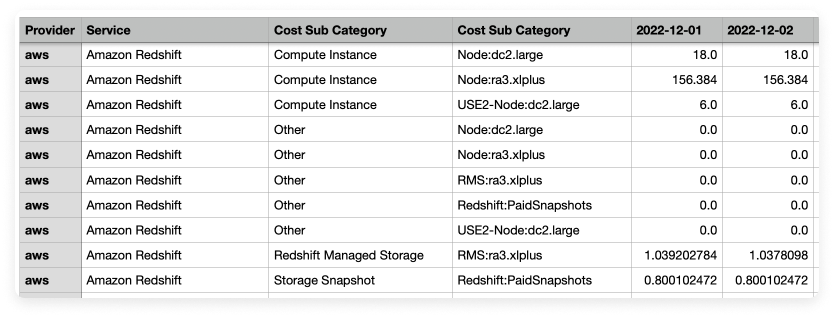Create a Cost Report
1
From the top navigation, click Cost Reporting.
2
On the left menu, select Cost Reports.
3
On the top right, click + New. A new, unfiltered Cost Report is displayed.
4
From the top left of the graph, click Filters.
5
Click + Add a Filter and select your desired filter criteria.
6
From the top right of the graph, use the date picker to select the date range for the report. You can select a date range that encompasses both previous and future dates, up to 6 months ahead. For more information on future forecast dates, see the Forecasting documentation.
By default, the Cost Report compares the selected dates to the same previous period. For example, the default comparison date for March 12–March 18 is February 12–18. To select a custom comparison:
- Open the date picker menu.
- In the left column, select Custom.
- On the calendar section select your desired date range. (The current month is selected by default.)
- Under Comparing to Previous Period, select the first date period field and select a custom comparison period.
- Click Apply.
- You can also enable or disable the previous period comparison on a report. Click the toggle next to the Previous Period on the Date Picker to toggle this setting on or off.
7
Select one of the following date bins:
- Cumulative: Displayed as a line, pie, or area chart on the graph, along with a forecast for line and area charts, if available. Also available as ungrouped bar charts.
-
Daily, Weekly, Monthly, or Quarterly: Displayed as a bar (multi-bar and stacked options), line, or area chart, with date ranges binned on the bottom axis and a forecast, if available.
Quarters are based on the below ranges:
- Q1: January 1–March 31
- Q2: April 1–June 30
- Q3: July 1–September 30
- Q4: October 1–December 31
Filter a cost report
Configure report groups
Configure Credits, Discounts, Refunds, Taxes
Enable/disable amortization
Perform comparative cost reporting
Save a Cost Report
After you apply all desired filters to the report, you can save your changes and name the report.1
From the top right of the graph, click Save As New to create a new Cost Report with your changes, or Save Changes to modify the current report.
2
Enter a name, then click Save.
If you update the date range, date bin (e.g., Last 30 Days), or grouping, you can also permanently save these changes. Once saved, the new date range, date bucket, and grouping will persist on the Overview page. If you save a report that includes only changes to filter sets, the report will be displayed on the Overview page with the last six months of costs.
Organize Cost Reports
Cost Report Folders
You can organize your Cost Reports in folders and separate them by team or group. See the Folders documentation for more information.Dashboards
Cost Reports can be displayed as a group on a dashboard. The dashboard has options to display all reports by the same date range. See the Dashboards documentation for more information.Anomalies, Forecasts, and Annotations
Cost Reports have several other features, including anomaly detection, forecasts, and annotations. See the linked documentation for more information about these features.Filter Cost Reports
On the Filters menu, click Select a provider and choose from any of your connected providers (AWS, Azure, etc.). Costs are filtered to all costs for the selected provider. Within the table, costs are grouped by provider service (e.g., Amazon Relational Database Service), in descending order of Accrued Costs.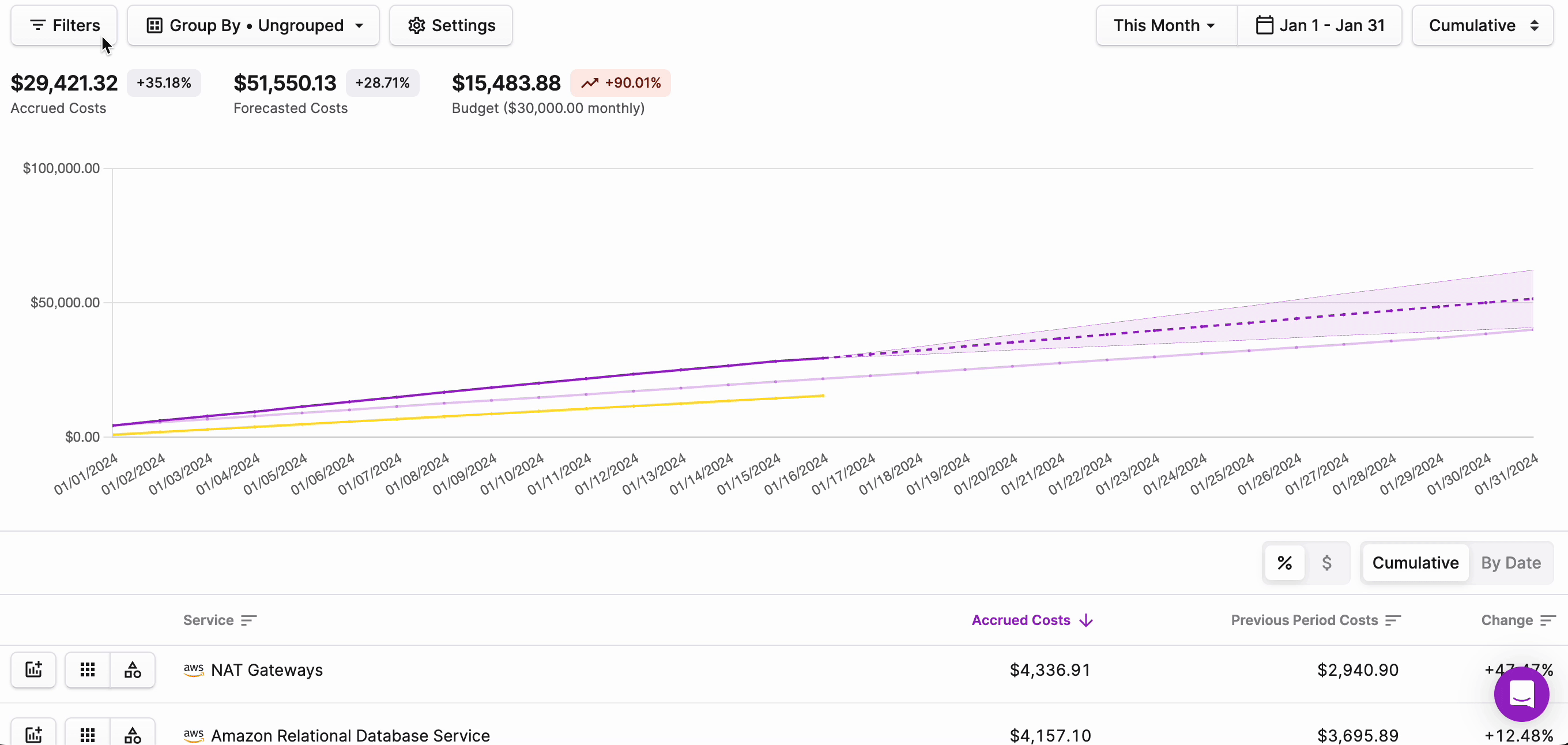
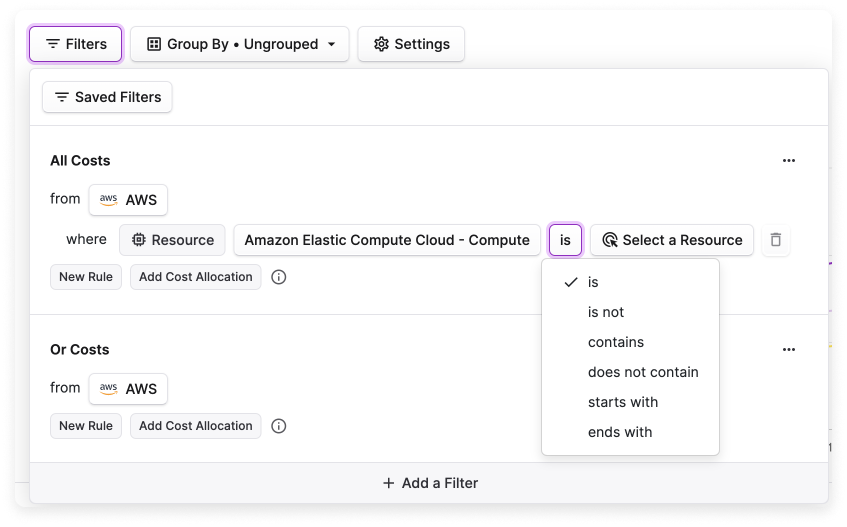
- To add another value for that filter, click the + icon next to the first value.
- To remove a selected filter value, click the trashcan icon next to the value.
- To add more filter criteria, click New Rule. The graph is updated to display costs that match the first filter criteria and the second filter criteria.
- To add a separate filter set, click + Add a Filter. You can also use this option to add costs from another provider. The graph is updated to display costs that match the first filter set or the second filter set.
- To remove a filter set, click the trashcan icon at the top of a filter set.
Flexible Match
The flexible match operator in Vantage helps you work with inconsistent tag naming conventions. When filtering a Cost Report, you can select the flexible match operator to ignore differences in case, whitespace, underscores, and hyphens. This allows a single filter to match many tag value variations without creating multiple filters or manually normalizing tags. For example, your organization tags workloads by team, but the tag values vary: one service might useteamA, another team-a, and a third Team A. Instead of creating separate filters for each variant, use the flexible match operator as shown in the image below.
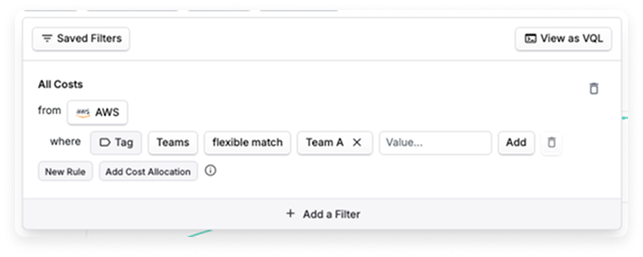
Team A string.
To exclude values, use the does not flexible match operator.
Percent-Based Cost Allocation
With percent-based cost allocation, you can filter Cost Reports to show back shared resources, like support costs or multi-tenant databases, to the team or department that uses them. As filters are set in a Cost Report, Vantage will query for costs that meet all those conditions. To set percent-based cost allocation:1
From the Filters menu, select your desired filter criteria. For example, select the AWS provider option and filter by Service for only RDS costs.
2
Click the Add Cost Allocation button on the filter set and enter a value between 1 and 100%. The set percentage will be applied to all the matching costs and represented accordingly in the Cost Report.

Amazon Elastic Container Service (ECS)-Managed Tags
If you want to view Amazon Elastic Container Service (ECS) cluster tags, you need to enable ECS-Managed Tags. See the AWS documentation for more information.AWS Organization Tags
You can filter and group by AWS Organization Tags in Cost Reports. Create a filter for Tag. For the Tag Key, these tags are displayed likeaws:organizations:tag.
Network Costs
For resources that generate network traffic costs (e.g., NAT Gateways), a Network Costs button is displayed in the Cost Report list. See the Network Flow Reports documentation for details on network costs. In the below example, this Cost Report is grouped by Service and Resource. The Network Costs button is displayed next to NAT Gateway resources.
Saved Filters
You can create and use Saved Filters to apply commonly used filters across multiple reports. Review the Saved Filters documentation for more information.Configure Report Groups
With the Group By option, you can select one or more dimensions to group by. If you select a grouping option, both the Cost Report table and graph will include costs aggregated by the selected groupings. Once the report is saved, the report’s corresponding Overview widget will be updated as well. You can group by the following dimensions:- Account (e.g., member account on AWS, project on GCP)
- Billing Account
- Region
- Service (e.g., Amazon S3, Azure VMs)
- Resource
- Provider (e.g., AWS, GCP, Azure)
- Category
- Subcategory
- Charge Type (see the section below for definitions)
- Tagged (e.g., see whether resources are or are not tagged)
- Tag (includes virtual tags)
production - Acme - nat-123456.
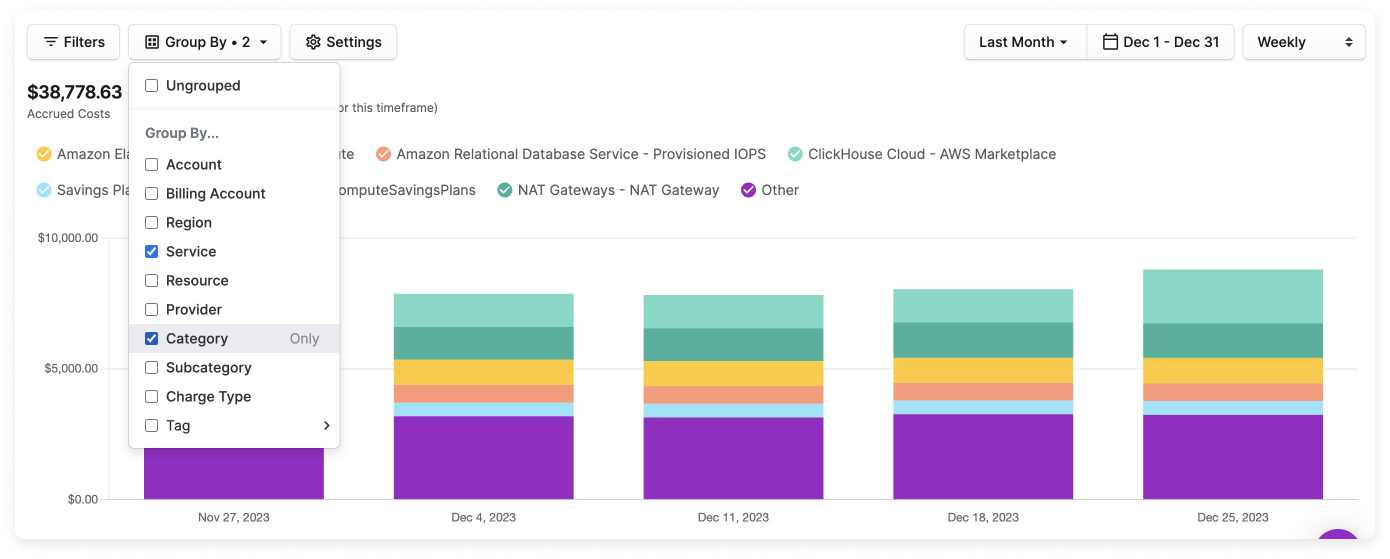
Charge Type Grouping Category
The Charge Type grouping includes costs separated by items like usage, discounts, EDP discounts, and taxes. Expand the section below to view the associated providers and definitions for each charge type.Click to view Charge Types
Click to view Charge Types
| Charge Type | Provider | Definition |
|---|---|---|
| adjustment | GCP | GCP adjustments due to reasons like goodwill or SLA violations |
| AllocatedAmortizedDiscount | AWS | The fee that is associated with the discount |
| AllocatedAmortizedFee | AWS | Savings Plans and Reserved Instances that have been amortized and allocated to an account with usage |
| AmortizedFee | AWS | Amortized Savings Plan and Reserved Instance purchases |
| AmortizedTax | AWS | Tax related to amortized savings plan and reserved instance purchases |
| AWS Marketplace | AWS | AWS Marketplace fees |
| Bundled Discount | AWS | Discounted usage for one product/service based on the usage of another product/service |
| Credit | AWS | Any AWS credits that were applied to your bill |
| COMMITTED_USAGE_DISCOUNT | GCP | Compute Engine resource-based committed use discounts |
| COMMITTED_USAGE_DISCOUNT_DOLLAR_BASE | GCP | Spend-based committed use discounts |
| DISCOUNT | Any provider | Discounts applied by a provider for your usage |
| DistributorDiscount | AWS | Discounts through the AWS Distribution Resellers Program |
| Enterprise Discount Program Discount | AWS | Discounts applied through the AWS Enterprise Discount Program (EDP) |
| Fee | AWS | Upfront annual fees paid for subscriptions, such as the fee paid for All Upfront subscriptions |
| FeeTax | AWS | Tax related to “Fee” type |
| FEE_UTILIZATION_OFFSET | GCP | Credit that offsets Committed Use Discount (CUD) fee SKUs when commitments are fully utilized, resulting in zero net cost for the fee SKU |
| FREE_TIER | GCP | Credits applied related to GCP Free Tier usage |
| Monthly Minimum Fee | Fastly | Minimum fee for Fastly |
| Private Rate Discount | AWS | AWS discount based on private pricing rates |
| PROMOTION | GCP | GCP promotional credits related to items like marketing promotions |
| Purchase | Azure | RI and Savings Plans purchases in Azure |
| Refund | AWS | Negative charges, indicating money refunded by AWS |
| regular | GCP | GCP regular charges |
| RESELLER_MARGIN | GCP | Discounts for GCP Reseller Program |
| Reserved Instance Discounted Spend | AWS | The rate for instances benefiting from Reserved Instance (RI) benefits. |
| Reserved Instance Fee | AWS | Monthly recurring fees for Reserved Instance subscriptions |
| RiVolumeDiscount | AWS | Volume discounts for large Reserved Instance purchases |
| rounding_error | GCP | GCP cost type for rounding errors |
| Savings Plan Discounted Spend | AWS | On-demand costs covered by your Savings Plan, offsetting corresponding Savings Plan negation items |
| Savings Plan Negation | AWS | Offset costs through your Savings Plan benefit associated with covered usage items |
| Savings Plan Recurring Fee | AWS | Hourly recurring charges associated with a No Upfront or Partial Upfront Savings Plan |
| Savings Plan Upfront Fee | AWS | One-time upfront fee from purchasing All Upfront or Partial Upfront Savings Plans |
| Solution Provider Program Discount | AWS | Discounts through the AWS Solution Provider Program |
| SUBSCRIPTION_BENEFIT | GCP | Credits earned after purchase of long-term subscriptions |
| SUSTAINED_USAGE_DISCOUNT | GCP | Credit for running certain Compute Engine resources for a large portion of the month |
| Tax/tax | AWS, GCP | Taxes applied, such as sales tax |
| Usage | Any provider (for GCP, see “regular”) | Charges for usage at regular or on-demand rates |
Other Grouping Category
By default, the top five groups of costs by amount are displayed on the graph. In addition, the Other Costs category is displayed as an aggregation of all remaining costs. To add more costs to the graph and table, click the down arrow next to Other Costs. The number of other costs is displayed. Click Show X More Items, to add additional cost groups to the report.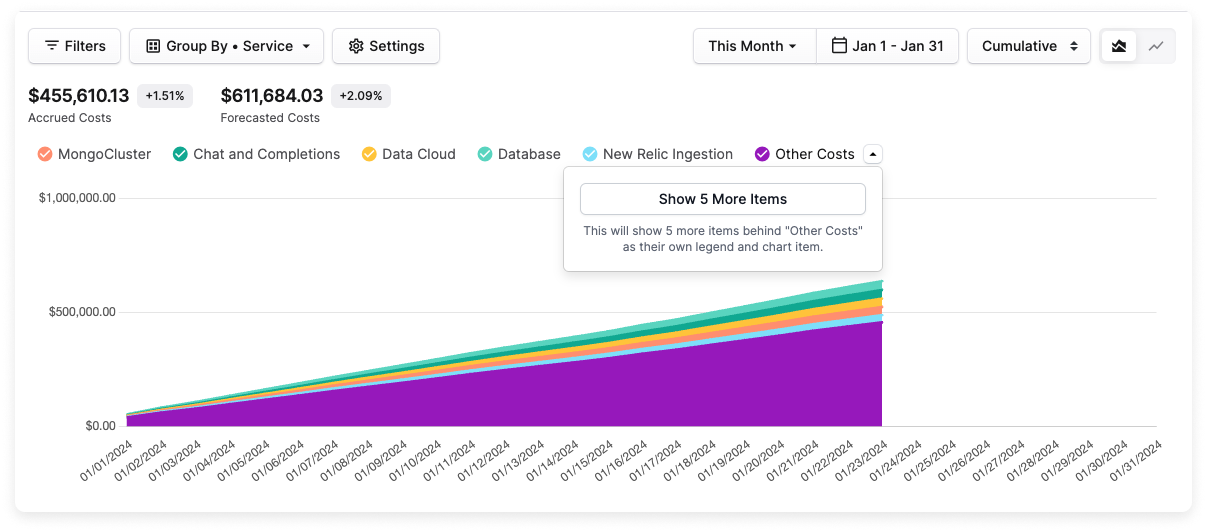
Drill Down in Costs Table
Within the table below the graph, you can drill down into your report to create precise filtering and grouping views. When you click a drilldown icon on a row, Vantage automatically adds filters matching the values in that row and adds a grouping dimension to the report, allowing you to explore your costs in more detail. The drilldown options available depend on whether the report is currently ungrouped or has grouping criteria applied.Starting from an Ungrouped Report
When a Cost Report is ungrouped (i.e., the Group By dropdown is set to Ungrouped), two drilldown icons are displayed next to each service in the table:- Costs by Category icon (shapes icon): Click to view costs broken down by category for that service. This adds a filter for the selected service and groups the report by Category.
- Costs by Resource icon (chip icon): Click to view costs broken down by individual resources for that service. This adds a filter for the selected service and groups the report by Resource ID. This option is only available for providers that support resource-level cost data, such as AWS.
Starting from a Grouped Report
When you manually apply grouping criteria to a Cost Report (e.g., set the Group By field to Service), the following drilldown options are available:- Quick drilldown icon: A single icon is displayed that represents the next grouping dimension in Vantage’s standard drilldown sequence. For example, if you group by Account, the quick drilldown icon will drill down by Billing Account. Hover over the icon to see what grouping it will apply.
- Drilldown menu: A dropdown menu (filter list icon) appears next to the quick drilldown icon, allowing you to choose any available grouping dimension to drill into, rather than using the automatically determined next grouping.
- Adds filters matching the values in that row (e.g., the specific service, category, or other grouping values)
- Adds the selected grouping dimension to the report
- Displays the new grouping as a column in the table
- The report is filtered to AWS costs and grouped by Service.
- On the line item for Elastic Compute Cloud - Compute, click the quick drilldown icon (which drills down by Category).
- A filter for line items matching only the Elastic Compute Cloud - Compute service is added in the Filters menu.
- The report is now also grouped by Category.
- The Category column appears in the table.
- You can continue to click the quick drilldown icon on subsequent rows to drill deeper into your costs. Each click adds filters for the selected row and applies the next grouping in Vantage’s standard sequence. For example, if you click the quick drilldown icon on the EC2 > Data Transfer line item:
- The Data Transfer category filter is applied in the Filters menu.
- The report is automatically grouped by Subcategory (the next grouping in the sequence after Category).
- Subcategory is also displayed as a column in the table.
- You can also use the Drilldown menu (the filter list icon) to choose which grouping dimension to drill into next, rather than using the automatically determined next grouping. In the below example, you select the Region option for the EC2 > Data Transfer > EU-DataTransfer-Out-Bytes line item. In the resulting report, EC2 > Data Transfer > EU-DataTransfer-Out-Bytes is broken down with individual line items per region.
- The additional filter for the EU-DataTransfer-Out-Bytes subcategory is added to the Filters menu.
- The report is now also grouped by Region (the selected grouping).
- Region is now a column in the table.
Navigating Drilldown History
After drilling down into your costs, you can use the back button in your browser to navigate back to the previous drilldown level. This allows you to easily move between different levels of detail without losing your place in the report.Tagging Drilldown
When a tag is a nested tag, you can drill down into its values to view all subtags. In the example below, the report is grouped by the nested tag Business Units. This tag contains two values—Core Production and Core Development—each made up of other tags.

Billing Code Descriptions
AWS practitioners who are having trouble understanding AWS billing codes present in Cost Reports can find descriptions of each billing code, other variations of that billing code, and other services that use the same billing code within Cost Reports. When you view any AWS Cost Report grouped by Provider, Service, Category, and Subcategory, you can hover over any subcategory line item and a tooltip with a link to cur.vantage.sh is provided that takes you to a page with details for that billing line item.cur.vantage.sh is a free utility that gives cloud practitioners simple definitions of billing codes for every AWS service. The site has a distinct page for each AWS service (e.g., S3 or EC2) that clusters together similar billing codes for that service, as there may be separate or distinct billing codes for each individual region.
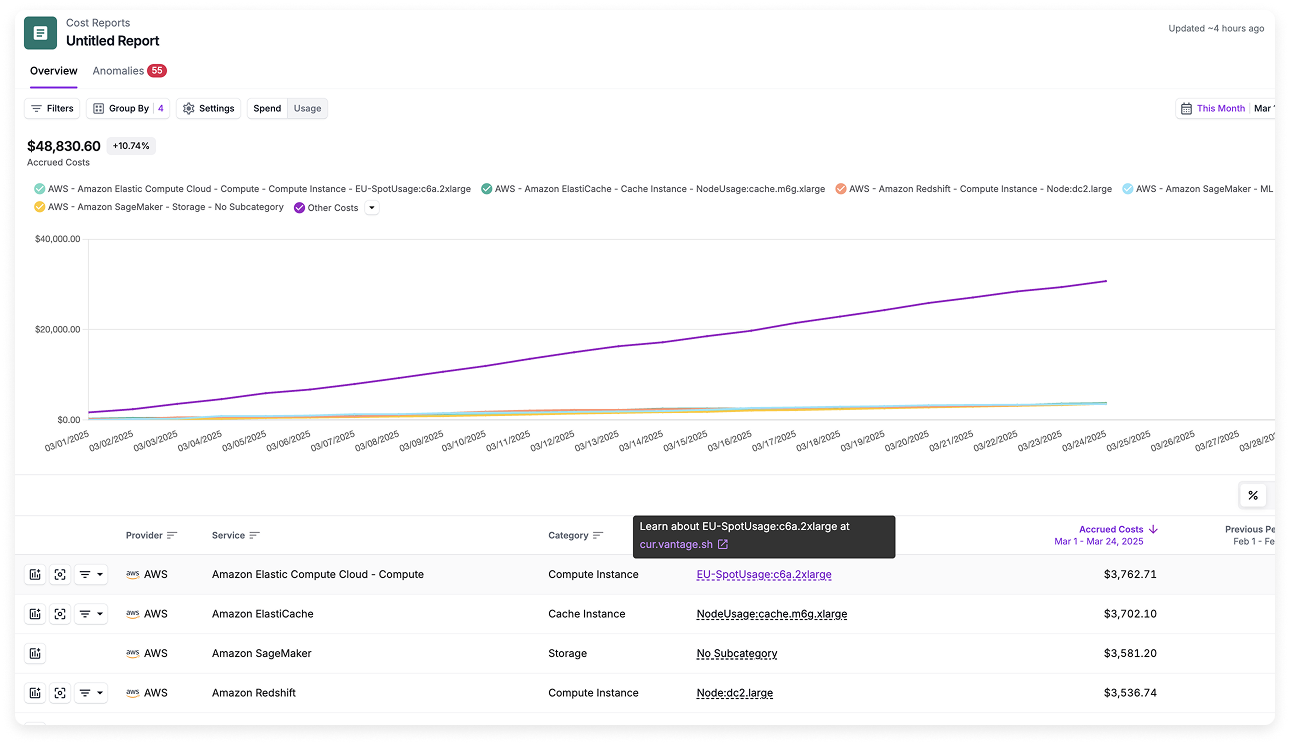
Adjust Chart Visualization
You can adjust the chart to show as one of the below options. To toggle these options, click one of the corresponding buttons on the top right of the chart.
- Bar Charts
- Line Chart
- Area Chart
- Pie Chart
- Stacked Bar: Segmented bars stacked on top of each other. Each bar shows cumulative total with different colors for each grouping (e.g., when grouped by provider, one bar for AWS, one for Azure, etc.). Available with Daily, Weekly, Monthly, or Quarterly date bins.
- Multi-Bar: Separate bars for each segment side-by-side for easy comparison across categories at each time point. Available with Daily, Weekly, Monthly, or Quarterly date bins.
Configure the X Axis
By default, Cost Reports display the date on the X axis with costs segmented by provider, service, or other dimensions. You can also configure the X axis to show different dimensions, giving you more control over how costs are grouped and visualized. The configurable X axis is compatible with bar charts—both multi-bar and stacked bar charts. If you want to change the chart type, you’ll be asked to confirm the change. If you proceed, the grouping will reset to by date.When you change the X axis to a non-date dimension, any existing Group By settings will be removed, and you will be unable to set additional Group By settings, as the chart will now be grouped by time period. In addition, annotations will not show in the chart itself; however, you can view your existing annotations by clicking on the Annotations icon in the top right of a Cost Report.
1
Apply any desired filters to the chart.Filters apply as normal. For example, you can filter a Cost Report to only AWS, then set the X axis to “Team” to compare team costs within AWS. The segmentation will always adjust to reflect the chosen X axis.
2
At the top of any Cost Report, select the Chart Settings dropdown.
3
Select your desired X Axis Group By dimension from the dropdown.
When you select a non-date dimension, the chart will update to show that dimension on the X axis, with date becoming the segmentation within the chart based on your selected date bin.
Click to view available options
Click to view available options
- Date (default)
- Billing Account
- Linked Account
- Region
- Service
- Resource ID
- Provider
- Cost Category
- Cost Subcategory
- Charge Type
- Tagged Status
- Tag Key (any available tag)
The maximum number of groupings on an X axis is 10 for multi-bar charts and 20 for stacked charts. All remaining items after these limits are aggregated into an “Other” bar. You can’t select multiple dimensions (e.g., provider and tag) to display on the X axis. The X axis group order is descending based on cumulative spend.
Configure Report Settings
Credits Discounts Refunds and Taxes
By default, all Cost Reports include discounts and taxes. You can optionally enable credits and discounts, too.- Credits: Credits are often promotional codes redeemed for services or trials on your account.
- Discounts: Discounts can include programs like the AWS Enterprise Discount program. Discounts are often negotiated with the cloud provider and based on usage. You might see discounts reflected as negative values in the Cost Report table. You can follow the below best practices for analyzing Cost Reports with discounts:
- If you remove the Discount setting, you can view usage and costs before the discount was applied.
- Group or filter the Cost Report by Charge Type. This grouping displays costs separated by items like usage, discounts, EDP discounts, and taxes.
- Refunds: Any associated refunds.
- Taxes: Any associated taxes.
1
Above the Cost Report graph, click Cost Settings.
2
Select an option to toggle on/off any of the included costs (e.g., discounts, etc.).
Amortization
By default, all Cost Reports show upfront fees, such as fees for Reserved Instances, Savings Plans, Marketplace purchases, and Support, amortized day by day for the period of the fee. In addition, Vantage uses committed use attribution for linked accounts. By default, you will see fees for Reserved Instances and Savings Plans assigned to the AWS account that benefited from the discount—not the account that purchased the commitment. For more information about this logic, see the following Vantage blog post.In contrast to AWS Cost Explorer, which displays fees associated with the account responsible for the commitment or purchase, Vantage provides a comprehensive view by showing fees based on the account where the benefits were realized.
Disabling Amortization
You can toggle a Cost Report to not amortize upfront fees if you want to view the upfront fees on the day they were incurred.1
From the top of any Cost Report, click Cost Settings.
2
Under Amortization, uncheck Enabled.
3
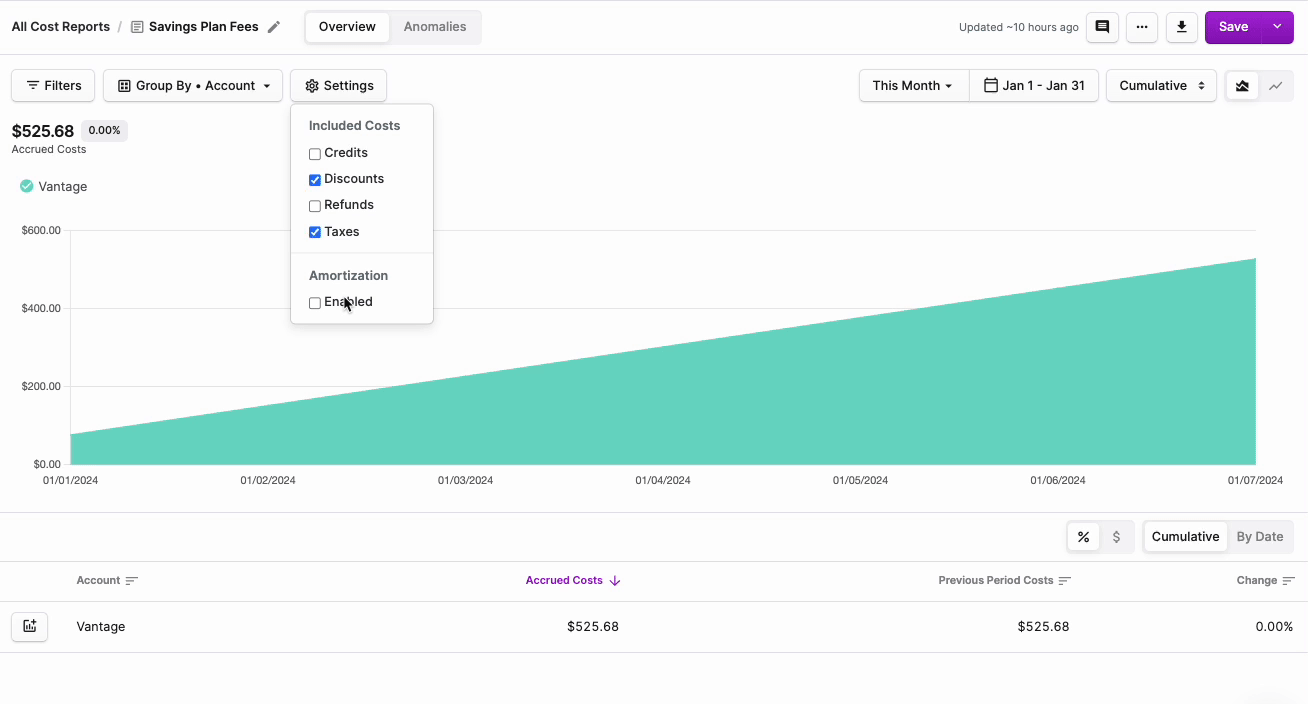
Vantage vs. Cost Explorer
If you notice your costs in Vantage differ from what you see in Cost Explorer, this could be for many reasons, including:- Amortization logic: As noted above, Vantage uses a different amortization logic from Cost Explorer.
- EC2-Other: In Cost Explorer, this cost category comprises many subcategories (e.g., Data Transfer). In Vantage, EC2-Other is reallocated into direct line items. For example, if you filter for NAT gateway expenditures, the charges initially categorized under transit or egress in EC2-Other are assigned to the individual resource that created the charge.
Usage-Based Reporting
Usage-Based Reporting provides infrastructure consumption in non-monetary metrics, such as virtual machine running hours, stored gigabytes of data, and read/write units consumed. These reports are available within Cost Reports, where you can toggle between viewing consumption by spend or by usage. See the Usage-Based Reporting documentation for details on how to use and view these reports.Comparative Cost Reporting
Side-by-Side Comparison Charts
Create comparative Cost Reports by configuring the X axis to show different groupings (like region, service, or team) and using multi-bar charts. This displays current and previous period costs side-by-side for each grouping, making it easy to compare spending across different categories.
1
Create a Cost Report with a multi-bar chart visualization.
2
Configure the X axis to group by your desired dimension (e.g., region, service).
3
The chart will automatically show current period and previous period bars for each grouping, allowing you to compare costs across different categories.
Update the Costs Table
To compare costs day by day, week by week, month by month, or quarter by quarter on Cost Reports, click the By Date option above the cost table. A view of costs with the same date binning selected for the graph is displayed. To switch back to the previous, current, and percent change view, select Cumulative.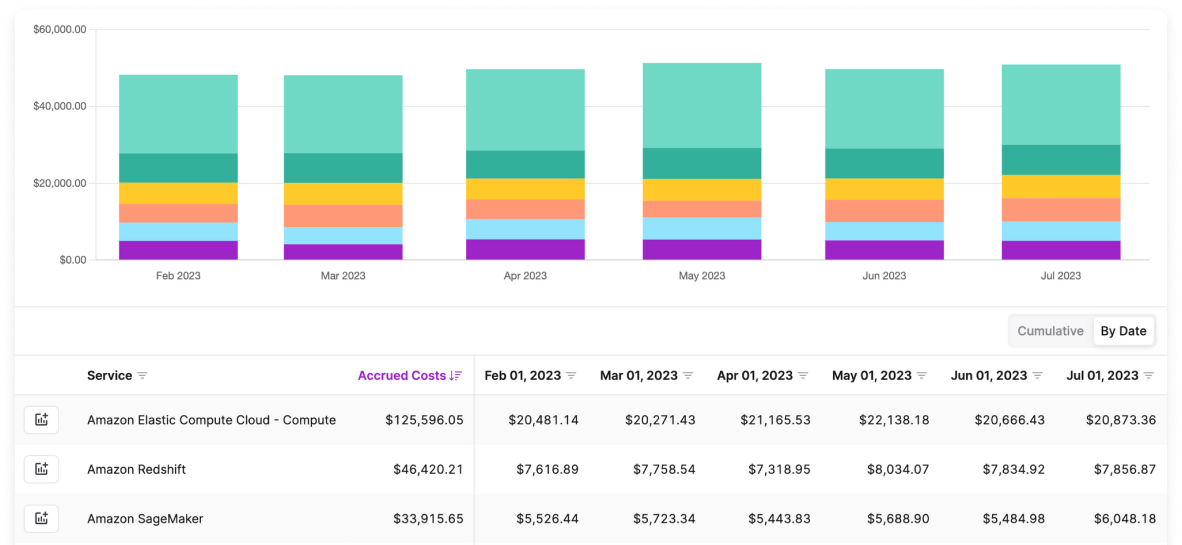
Export Cost Reports
You can export Cost Reports as CSV or PDF files to share with other Vantage users. You can also create an export that includes both file formats. Reports with Configurable X Axis settings can be exported just like any other report.Export a Cost Report that matches your current filters, dimensions, and date range. To change dimensions, update the underlying report before exporting.
- PDF Exports
- CSV Exports
PDF exports include the following elements:
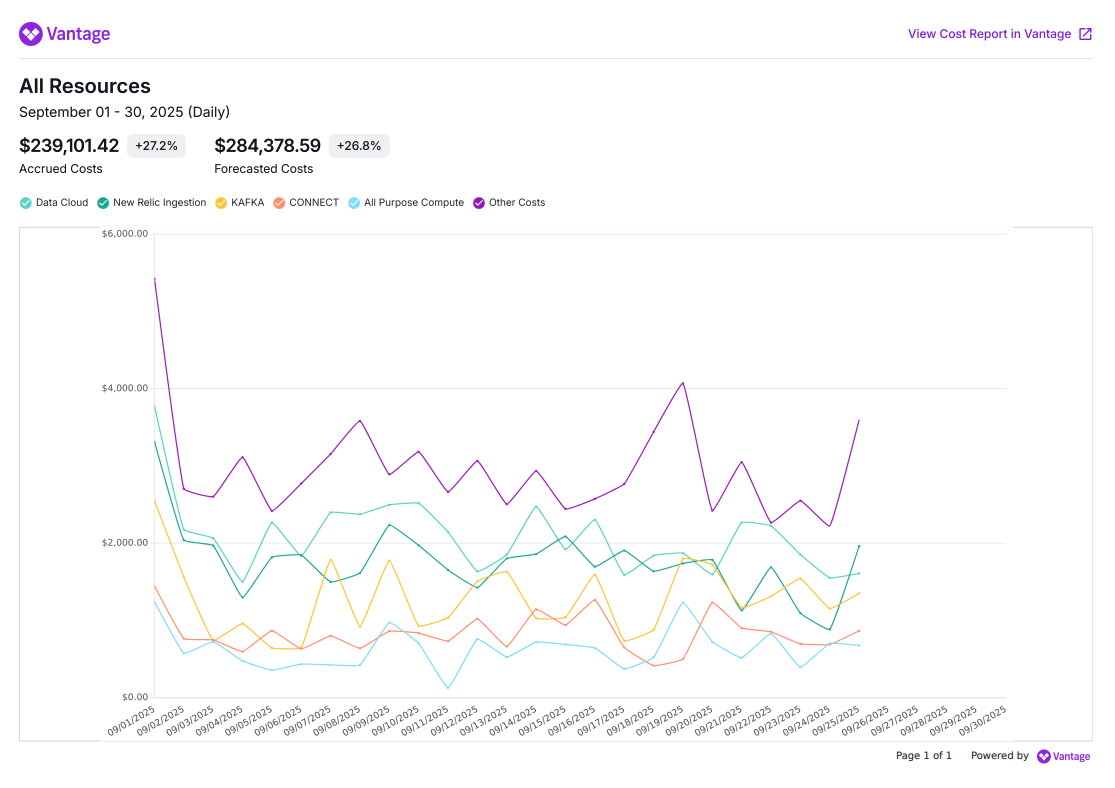 If your Cost Report has any associated business metrics, budgets, or a forecast, these elements will also be displayed.
If your Cost Report has any associated business metrics, budgets, or a forecast, these elements will also be displayed.
- Cost Report title
- Date range
- Link at the top to the associated Cost Report in Vantage
- Accrued costs represented in the Cost Report
- Color-coded legend for the Cost Report groupings
- Graphical representations of your Cost Report (supports all Vantage chart types)
Click to view example image
Click to view example image

1
Open any Cost Report.
2
From the top right, click the download icon (looks like an arrow with a line below it).
3
The Export Data modal is displayed. Select any relevant Groupings, which will be expressed as additional columns in CSV exports and in the chart legend of PDF exports.The columns can be any combination of groupings from the following list:
- Provider (e.g., AWS, GCP, New Relic)
- Service (e.g., EC2, EBS)
- Region (e.g., us-east-1)
- Service category (e.g., Storage, Compute)
- Service subcategory (e.g., m5.large, StandardTier)
- Charge Type (e.g., Usage)
- Account (e.g., AWS member account, GCP project)
- Billing Account (e.g., billing account name)
- Resource ID (e.g., S3 bucket ARN, MongoDB Atlas cluster name)
- Usage (toggle to export Usage-Based Reporting data)
- Tag key, which will be included as an additional column in the export, in the following format:
Tag:<TAG KEY>(e.g.,Tag:Project).
4
For File Format, select CSV, PDF, or both.
5
Enter the emails of Vantage users who should receive the export.
6
Select a date range and date bin for the export.
For the Date Bin export option, when you select Week, the week in the export will begin on Monday, UTC. When you select Month, the month in the export will begin on the first of the month, UTC.
7
For the Schema option, select either Vantage’s default schema or the FinOps Foundation FOCUS schema.
If your Cost Report has an associated business metric, a separate toggle is displayed at the bottom of the export modal. This allows you to export unit costs alongside your cost data as a separate CSV file.
8
Click Export.
Starred by Me
If you want to save your favorite Cost Reports or folders to a convenient location, you can star specific resources.1
From the All Cost Reports screen, select the checkbox next to one or more Cost Reports.
2
Above the list, click Star. A star icon will be displayed next to the report.
3
To access all starred reports, navigate to the Starred By Me screen, also accessible from the left Cost Reporting navigation pane.
